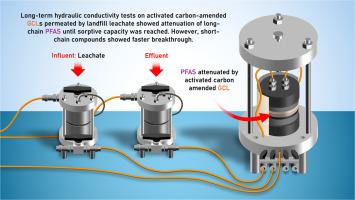土工合成粘土衬垫对pfas影响的渗滤液的长期水力和密封响应
IF 7.7
Q2 ENGINEERING, ENVIRONMENTAL
引用次数: 0
摘要
本文探讨了单个土工合成粘土衬垫(GCL)组分和活性炭改性粘土衬垫(ACA-GCL)对来自澳大利亚两个垃圾填埋场的渗滤液(本文称为渗滤液A和渗滤液b)中的单氟烷基和多氟烷基物质(PFAS)的衰减效果。对GCL及其组分进行了批量吸附试验,以评估它们对20种环境重要的PFAS的吸附亲和力。同时对活性炭改性的gcl进行了660 ~ 1111天的长期渗透性能测试。批量测试结果表明,随着碳链长度的增加,PFAS的吸附量增加,这可能是由于疏水相互作用的增强。相反,所有吸附剂对短链PFAS的吸附都很小,甚至可以忽略不计。对于渗滤液A和渗滤液B经活性炭修饰的GCL样品,其水力传导率测试的值分别为k = 7.6 × 10 - 11 m s⁻¹和k = 6.2 × 10 - 11 m s⁻¹,表明与常规GCL相比,其传导率有适度的增加。此外,在整个测试期间,对水力导电性废水在不同间隔的采样表明,活性炭修饰的GCL样品与常规GCL相比,显著延缓了28个目标PFAS的突破。PFAS的突破时间取决于末端头基团和碳链长度,越长的全氟碳链的突破时间越长。综上所述,虽然活性炭修饰的gcl可以有效地延缓长链PFAS的迁移,直到达到其吸附能力,但它们在解决短链化合物迁移方面的效果较差,这是一个重大挑战。为了防止PFAS随着时间的推移迁移,可能需要坚固的填埋衬垫设计,例如那些含有能够衰减短链PFAS的材料。本文章由计算机程序翻译,如有差异,请以英文原文为准。

Long-term hydraulic and containment response of geosynthetic clay liners to PFAS-impacted leachates
This paper explores the efficacy of individual geosynthetic clay liner (GCL) components and an activated carbon-amended GCL (ACA-GCL) in attenuating per- and polyfluoroalkyl substances (PFAS) from leachates obtained from two Australian landfills, denoted herein as leachates A and B. Batch sorption tests were performed on GCLs and their components to evaluate their sorptive affinity for 20 environmentally significant PFAS. Long-term hydraulic conductivity tests were also performed on activated carbon-amended GCLs subjected to leachates for 660 to 1111 days. Batch test results indicated that PFAS sorption increases with longer carbon chain lengths, likely attributed to enhanced hydrophobic interactions. Conversely, all sorbents exhibited minimal to negligible sorption of short-chain PFAS. Hydraulic conductivity tests yielded values of k = 7.6 × 10−11 m s⁻¹ and k = 6.2 × 10−11 m s⁻¹ for activated carbon-amended GCL specimens permeated by leachates A and B, respectively, indicating a moderate increase compared to conventional GCLs. Furthermore, sampling of hydraulic conductivity effluents at various intervals throughout the testing period demonstrated that the activated carbon-amended GCL specimens significantly retarded the breakthrough of 28 target PFAS compared to conventional GCLs. PFAS breakthrough time varied depending on the terminal head group and the carbon chain length, with longer perfluorocarbon chains exhibiting extended breakthrough times. Overall, the results suggest that while activated carbon-amended GCLs can effectively retard the migration of long-chain PFAS until their sorptive capacity is reached, they are less effective in addressing the migration of short-chain compounds, which presents a significant challenge. To prevent PFAS migration over time, robust landfill liner designs may be required, such as those incorporating materials capable of attenuating short-chain PFAS.
求助全文
通过发布文献求助,成功后即可免费获取论文全文。
去求助
来源期刊

Journal of hazardous materials advances
Environmental Engineering
CiteScore
4.80
自引率
0.00%
发文量
0
审稿时长
50 days
 求助内容:
求助内容: 应助结果提醒方式:
应助结果提醒方式:


